Putting Your Money Where Your Heart Is
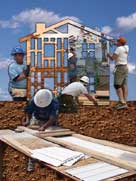
Inspired and supported by our advertisers and readers like you, the parent company of Roofing Contractor sponsored one of the more than 200 homes built in Michigan during Habitat for Humanity's 2005 Jimmy Carter Work Project (JCWP) this summer. The BNP Media house was one of 30 homes completed in Detroit during the "blitz" week of the JWCP this summer. BNP Media personnel, over 40 strong, also pitched in by taking time off to join thousands of other volunteers providing labor to build these homes.
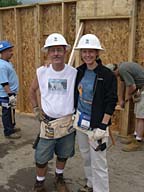
A Natural Fit
BNP Media is a fourth-generation family owned and operated enterprise headquartered in Troy, Mich. It was a natural fit for a family business to become involved in a project so near to home as well as the heart. The effort to sponsor one of the JCWP homes was spearheaded by Tim Fausch, director of publishing for the company's Construction Division. Under Fausch, the Construction Division of BNP Media publishes periodicals and newsletters, manages Web sites, and stages seminars and trade shows geared to a dozen or so construction trades, including roofing.This involvement in the construction industry made for a great opportunity for many of BNP Media's journalists to gain some hands-on experience as volunteer construction workers. It is one thing to talk about roofing and write about roofing, and quite something else to throw a bundle of shingles on your shoulder, haul it across the roof, tear it open and start nailing. For example, Roofing Contractor publisher Jill Nash may now justifiably add framing carpenter, roofer and painter to her résumé.
Habitat for Humanity is an ecumenical Christian ministry that was founded in 1976 by Linda and Millard Fuller with the simple goal of eliminating all substandard housing from the planet. The Habitat model is a partnership between churches, businesses, and individuals who furnish funding and volunteer labor to build homes in partnership with people who cannot otherwise afford to purchase a home. Habitat homeowners pay full price for the home, and pay it off with a no-interest mortgage.
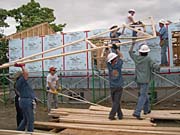
Detroit Battles Back
Hurricane-ravaged areas of the Gulf remain in the news as residents of the region seek to rebuild their lives. The televised images of the devastation that occurred in sections of New Orleans prompted calls for the federal government to step in and help the region rebuild. Figures ranging from 250,000 to 300,000 homes and buildings are expected to be a total loss.Not so dramatic, until you visit there or look at the numbers, has been the decline of the city of Detroit. Blight is visible as you move around certain sections of the city. It is said that as many as 25 percent of buildings are abandoned there. The population of Detroit has fallen from a high of 1.8 million in 1950 to just over 900,000 in 2004 - a loss of nearly half of the city's residents. Once an industrial powerhouse, Detroit is no longer one of the top 10 most populous cities.
That is the bad news. The good news hinges on the awesome opportunity this city has to rebuild, and the 2005 Jimmy Carter Work Project is evidence that it can happen. The 2005 JCWP leaves Detroit with 30 new homes that will provide security and shelter for thirty hardworking families. While land to build on is a major hindrance for affordable housing in many parts of the country, it is inexpensive and available in Detroit.
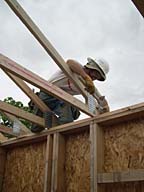
Let the Building Begin
The Jimmy Carter Work Project has been an annual affair since 1984, when former president Jimmy Carter and his wife, Rosalynn, went to New York to work with Habitat rebuilding homes. Each year the JCWP goes to a different region around the world, building homes with the local affiliate of Habitat for Humanity. Habitat builds what it describes as "simple, decent homes," and the resulting structures are always in line with the local translation of that concept. In Detroit, the homes were 1,150-square-foot ranch-style homes built over an unfinished basement.The local affiliate, Detroit Habitat for Humanity, was responsible for all of logistics with support from Habitat for Humanity International. As "blitz" builds go, Detroit HFH really had its act together. When volunteers arrived on the site, the basements were in and the prefabricated stud walls were on site ready to be placed. Engineered trusses were ready to set, and an enclosed semi-trailer donated by Whirlpool Corp. (headquartered in Michigan and a major donor to Habitat for Humanity) was filled with most of the components needed to build the house.
The first nail driven on House No. 20 was at the hand of the homeowner, Efrain Guevara. Guevara, like all Habitat homeowners, had to invest many hours of "sweat equity" into his and other Habitat homes as part of his down payment. In fact, he spent the entire week on site as one of the volunteer constructors. His wife, Demaris, also spent some time working on the site and provided a homemade lunch for all the workers at midweek.
The frame house took shape quickly. The exterior was quickly skinned with OSB and a thick layer of blue Dow insulation. Dow is also a major donor to HFH and the company's trademark blue board can frequently be seen on Habitat homes as they are being built. At the same time that the roof covering was being applied, volunteers started wrapping the exterior of the house with vinyl siding. Thankfully, volunteer professionals from the Vinyl Siding Institute (VSI) were on hand to give instruction, provide direction, and answer questions. They even helped with some of the trickier details and pitched in whenever any of the homes fell behind schedule.
The roofing was well designed for the climate in this upper part of the Midwest. The roofs were of a simple gable construction, not too steep, and easy for volunteers (even journalists) to walk. Once decked, the roof covering started with two courses of ice guard at the eaves. On house No. 20 a couple of Southern boys had the job of installing the membrane. David Stewart, a volunteer from Norcross, Ga., assisted the author with the task. A renewed respect for the talents of real roofers was discovered as the finer points of installing a self-adhering membrane were learned the hard way.
Following the rest of the dry-in, GAF Timberline shingles were applied over the course of two days. Again, it is one thing to write about roofing, but it is a genuinely unique experience for a non-roofer to head home with the raw knuckles and purple fingernails and traces of asphalt and glass fibers in places too delicate to mention - and soreness in places you did not realize you had.
The interior finishes were conventional and simple. At the end of the week, a simple, decent home was quite nearly ready to accommodate this family of seven. When you stand back and survey the structure, you are reminded just how important the work we in the roofing business do in providing comfort and shelter to the masses.
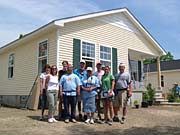
The Neighborhood
So how do 30 new homes in Detroit make a difference? These 30 homes were built on lots formerly occupied by two homes, and set into an old neighborhood that really defined the state of decline you see in many parts of Detroit. Now, thanks to the JCWP 2005, there is a state-of-the-art playground in the middle of all the new homes together with all of the existing homes in the area. It only takes a spark to get a fire going, and it is likely that homeowners in this area will take a new interest in fixing up their own places.
Speaking of the playground, it is certain that the addition of young families, like the Guevaras, with young children will bring a new life to this area. The stability that comes from homeownership is at the heart of the mission of Habitat for Humanity International. And, speaking of "international," a tithe portion of BNP Media's JCWP 2005 sponsorship was contributed by Detroit HFH to build homes in other parts of the world, especially the areas affected by last December's tsunamis.
It's Your Turn
If you are really adventurous, consider volunteering for the next JCWP slated for Mumbai, India, in October 2006. President Carter's mother, Lillian, served in the Peace Corps there, making Mumbai something of a sentimental choice for president Carter.Habitat for Humanity does the bulk of its work through local affiliates like Detroit HFH. There is most likely a Habitat affiliate in or near your town. You can contribute materials, labor (there is always a need for professional labor; volunteers cannot perform some tasks), or expertise to your local affiliate. The HFH affiliates are working hard to build a better community for local families and businesses.
Thanks for supporting this publication; we could not have sponsored the Guevara's home without you.
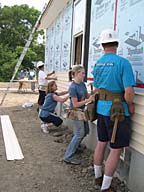
SIDEBAR: Habitat for Humanity International
Habitat for Humanity International is a nonprofit, ecumenical Christian housing ministry. HFHI seeks to eliminate substandard housing and homelessness from the world and to make decent shelter a matter of conscience and action.HFHI has built more than 200,000 houses around the world in its first 28 years, providing more than a half a million people with safe, decent, affordable shelter. The organization expects to build another 200,000 homes in the next five years.
Through volunteer labor and donations of money and materials, Habitat builds and rehabilitates simple, decent houses with the help of homeowner (partner) families. Habitat houses are sold to partner families at no profit, financed with affordable, no-interest loans. The homeowner's monthly mortgage payments are used to build still more Habitat homes.
HFHI's work is accomplished at the community level by affiliates, which are independent, locally run, nonprofit organizations. There are more than 1,900 active affiliates in over 100 countries; 1,600 of them are in the United States.
Partner families are selected based on level of need, willingness to participate in the program and ability to repay the no-interest loan. Neither race nor religion is a factor in choosing partner families.
Habitat is not a governmental agency and does not typically accept government funds for construction of houses, but the organization does work with government agencies toward fulfilling its mission of eliminating poverty housing. HFHI is managed by an ecumenical, international board of directors.
Learn more about Habitat for Humanity online at www.habitat.org.
Looking for a reprint of this article?
From high-res PDFs to custom plaques, order your copy today!




